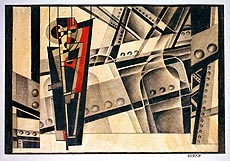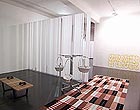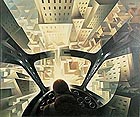
translated and summarized by: Liz Wollner-Grandville,
October 1 - 8
Leopold Museum: Zwischen den Kriegen - Österreichische Künstler 1918 - 1938
Affirmation Crisis
One of the main predicaments of art exhibitions is if one should only exhibit what is considered to be really good art. In practice this is what is nearly always affirmed. Thereby an exhibit itself is transformed into an instrument of affirmation and excludes those works, which do not meet certain quality standards. However, these pieces should not be completely disregarded as they often have an important historical message and background. This mechanism of exclusion is responsible for the fact that the Austrian public has very limited information about art and sculptures made during the Nazi-time or the time between the wars.
The exhibit at the Leopold Museum is trying to prove that the Moderne actually existed in Austria. In addition the large-scale show reinforces the pluralism of the time between 1918 and 1938. Magical Realism (Franz Sedlacek, Rudolf Wacker), Wiener Kinetismus (Erika Giovanna klien, Elisabeth Karlinsky) Expressiver Kolorismus (Wilhelm Thöny, Jean Egger).
The Austrian artists were by far not as isolated as many assumed. Works by Carry Hauser and Franz Probst are reminiscent of George Grosz and others, such as pieces by Friedl Dicker or My Ullmann, can unhesitatingly be compared to international constructivist movements.
Art collector Rudolf Leopold`s intention to accord the displayed artwork a higher ranking in the art history books - an intent that he clearly stated in his everything but modest preface - may not have been accomplished. But in any case, the display is essential and well worth seeing. Discoveries can be made and new facts revealed about the situation of the Austrian Intelligenzija during Austria`s First Republic.
until 28 January, 2008
www.leopoldmuseum.org
Grazer Kunstverein: Die Blaue Blume
On the Configuration of Modernistic Utopias
Under the direction of Soeren Grammel the Grazer Kunstverein is experiencing a revaluation of questions pertaining to spatial configurations and their reciprocal effect in a field of art, whose origin within the modernistic school of thought dates back to the beginning of the 20th century. Grammel selected a composition by Bauhaus member Anni Albers as a kind of starting point for the current exhibit Die Blaue Blume. Originally intended as a tapestry, Albers work is placed on the floor of the main exhibition room, reconstructed and altered in size.
In the first big room of the Kunstverein you will find a steel strap created in 1920 by the Russian-Polish sculptor Katarzyna Kobor. Albers tapestry was made in the same year, whereby the concept underlying Russian Constructivism is combined with that of the German Bauhaus.
More recent compositions are grouped around these two historically succinct pieces of art, which were created as a direct reaction to Albers, or consciously chosen in this context. Among them is Hillary Lloyd`s diascopic projection of different variations of colored cardboards. The modernistic discourse which is being held in this objet d`art, refers to the gateway between manual and industrial production, which was considered to be the decisive factor of art- and object composition during the Bauhaus era.
until 15 December, 2007
www.grazerkunstverein.org
GAMeC - Galleria d`Arte Moderna e Contempranea di Bergamo: Il futuro del Futurismo
The Future of the Past
Futurism, the art movement founded in Italy in 1909, will celebrate its centenary in 2009. A comprehensive Futurism exhibit is planned to take place in Milan in the fall of 2008. GAMeC, however, the young and dynamic art exhibition hall in the city of Bergamo, has already now taken the initiative to secure major works of this era. The exhibit is not meant to be a retrospective - "we would have never had enough money to do that", said Giacinto di Pietranitonio, GAMeC`s main curator - but rather fathoms which effect Futurism has on contemporary art.
"Il futuro del Futurismo" (The Future of Futurism) presents 200 works created during a century in which art positions, consciously or unconsciously, were drawn from the wealth of the Manifesto series, initiated by Filippo Tommaso Marinetti in 1909.
The show is grouped into nine themes and offers a wide variety of Futurism artwork ranging from Balla to Boccionie, from Depero to Carrá and Severini as well as correlated contemporary compositions. Among the 120 artists on display you will find many internationally renowned names such as Lucio Fontana, Paul McCarthy, Damien Hirst, Mimmo Rotella, Gilbert & George, Candice Breits, and Wolf Vostell just to name a few.
until 24 February, 2008
www.gamec.it
Künstlerhaus Graz: alien productions - Der Gedankenprojektor
Baby Squid - Cooked in its own Ink*
The eye is undoubtedly the most important and sole instrument of perception and observation in connection to visual media such as TV, film, and video. Our organ of sight is the central theme in the installation Gedankenprojektor (Thought Projector) shown by the Grazer Künstlerhaus and produced by alien productions (Martin Breindl/Norbert Math/Andrea Sodomka/August Black). With the help of an inversion procedure the eye plays the leading part in this monumental video staging. Newest technologies are used to examine the eye`s memory function. Every visitor's eye ground and iris are photographed and shown in real time on three huge screens that capture the exhibition space like a triptych.
"Are thoughts still free even if they are being photographed, educible, or even more alarming, interpretable?" These are questions asked by Werner Fenz in the accompanying text of the exhibit. In an age in which surveillance cameras are constantly watching all of us this is a disturbing question.
The ingenious scientist Nikola Tesla initiated the idea for this show. Tesla had always dreamt of constructing a machine that can record thoughts. Nowadays any Internet user could monitor eye scans, add his/her own interpretation, and publish the installation on the web.
At the end of the exhibit the Künstlerhaus plans to put together an eye-gallery, comprised of selected photos made during the show. On the basis of this preemptive art experiment, we might then be able to conclude if progress has been made concerning mind-reading techniques and if we will ever be able to free ourselves again from this frightening situation. Surveillance in the field of art is still a very sensitive and suspenseful topic.
* Quote by the virtual parapsychologist Dr. Johan Svenstrom
until 28 October, 2007
www.museum-joanneum.steiermark.at
Mehr Texte von translated and summarized by: Liz Wollner-Grandville


 Teilen
Teilen





